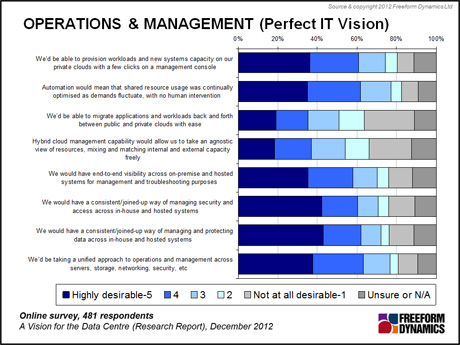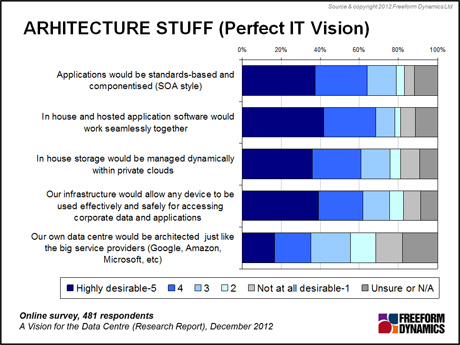By Tony Lock
There has never been a clearer understanding of how quickly business is changing and how rapidly IT technologies are evolving. With this in mind, we recently ran an online survey to ask readers of the Register how they thought data centres would develop between now and the year 2020. This is a period long enough for significant things to happen, but not so long that we end up in the realms of total science fiction or fantasy.
During the survey, we gathered responses from both mainstream enterprises and representatives of IT suppliers. As supplier views were so different in many respects (generally a lot more optimistic), we have put them aside for our discussion here and will come back to them in a later article. Even the enterprise and SMB views we will be looking at, though, are likely to reflect a more progressive view of the world as those with a greater enthusiasm for the topic are more likely to have responded.
With that health warning, let’s take a look at the results we got back.
Vision of the Future
When looking to the future, we asked readers of The Register, “Putting all of the existing constraints and the current state of the industry to one side for a minute, how desirable would the following be as part of your perfect IT vision?” The responses are analysed below:
To the cloud or not?
Cloud solutions, be they ‘Private’, ‘Public’ or ‘Hybrid’ in nature, have received considerable coverage over the past few years. Some pundits and advisors have even talked about a wholesale move to cloud computing of one form or another, with the consequent disappearance of traditional systems and methods. Most respondents don’t buy into this notion of a huge shift being on the cards, however, particularly in relation to public cloud (Figure 1).

Figure 1
While we haven’t shown it explicitly here, if we look behind this chart, it is the very smallest of organisations, those with fewer than 10 staff, that are the least attracted to the notion of a world dominated by public and private cloud solutions, perhaps on the assumption that such offerings are not designed to meet their needs. This is ironic given the number of times we hear about cloud potentially benefitting smaller companies.
Despite such mixed views, when you break the cloud idea down into specific capabilities, many more see the relevance, so let’s look at this in a bit more detail.
Visions of Operations and Management
When it comes to how Reg readers see various aspects of operations and management functioning in a “perfect” vision, there is a large degree of uniformity in responses across a range of areas (Figure 2).

Figure 2
The results indicate that a clear majority of respondents see a lot of value in solutions capable of simplifying and automating key administrative processes. Perhaps the most surprising element on the chart is that there are still some, around one in six, who perceive such capabilities as being not interesting or relevant at all. The only area where there is particular disinterest is hybrid cloud management and sourcing. The relatively limited interest in public cloud (at least within this sample) partially explains this finding, but there is also an element of some respondents seeing clear demarcation between the hosted and on-premise environments – the ‘horses for courses’ mentality. While this group may take advantage of discrete cloud services, they want to keep them separate.
The next chart (Figure 3) illustrates very clearly that the concept of different IT specialists to work together as fully integrated operations teams is very widely accepted and seen to be desirable by a substantial majority. It should be noted that acceptance patterns are very similar across organisations of all sizes.

Figure 3
The three in five respondents, who see IT activities and investments revolving around the concept of business services (rather than systems), may also mark a major milestone in the thinking of the IT professionals who make up the vast majority of our survey sample. Whilst this may be a manifestation of early adopter thinking, the very widespread acceptance reported here is unusual, and it will be interesting to see how quickly these ideas transfer into adoption.
It is also notable that almost two thirds of respondents would value the ability to report IT costs easily and accurately based on activity or resource consumption. In the past, chargeback has rarely been used in many organisations except in very simplistic models.
Taken together these results are very much in line with the ideals that Freeform Dynamics has been discussing as important to the future of IT service delivery. Getting IT teams working effectively to supply business users with the applications, data and services they require is central to the success of every organisation, and holds great potential. It helps IT to not only respond quickly to change requests from users, but to do so securely and cost-effectively.
When the concept of ‘business services’ moves from being visionary to actually being a natural part of the day to day working practices, IT will also put itself in a position where it can become far more proactive in putting forward the new opportunities that technology makes available. But such advice and suggestions will need a boost in the trust business users place in IT, something which is likely to be bolstered by improvements in responsiveness and service levels. Bringing greater transparency to IT costing via activity or consumption charging will also help.
The final chart on visions of the future looked at how systems should be architected and the results are shown in Figure 4.

Figure 4
The chart highlights how widely the idea that applications would be built using “Component” type architectures is seen to be desirable. It is worth remembering that just a few years ago SOA encountered considerable resistance from the IT community, but its value now appears to be recognised. Such acceptance may grow further as organisations look to IT to support new business processes or as existing ones are modified in response to rapidly varying business challenges and as modern coding tools and techniques are adopted.